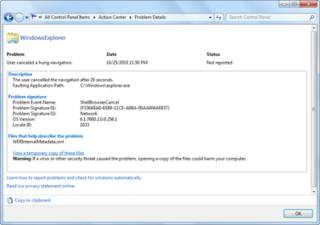Microsoft Windows was announced by Bill Gates on 10 November 1983, 2 years before it was first released. Microsoft introduced Windows as a graphical user interface for MS-DOS, which had been introduced two years earlier. The product line evolved in the 1990s from an operating environment into a fully complete, modern operating system over two lines of development, each with their own separate codebase.
Microsoft Windows is a product line of proprietary graphical operating systems developed and marketed by Microsoft. It is grouped into families and sub-families that cater to particular sectors of the computing industry -- Windows (unqualified) for a consumer or corporate workstation, Windows Server for a server and Windows IoT for an embedded system. Defunct families include Windows 9x, Windows Mobile, Windows Phone, and Windows Embedded Compact.

Microsoft Office, or simply Office, is a family of client software, server software, and services developed by Microsoft. It was first announced by Bill Gates on August 1, 1988, at COMDEX in Las Vegas. Initially a marketing term for an office suite, the first version of Office contained Microsoft Word, Microsoft Excel, and Microsoft PowerPoint. Over the years, Office applications have grown substantially closer with shared features such as a common spell checker, Object Linking and Embedding data integration and Visual Basic for Applications scripting language. Microsoft also positions Office as a development platform for line-of-business software under the Office Business Applications brand.

Windows XP is a major release of Microsoft's Windows NT operating system. It was released to manufacturing on August 24, 2001, and later to retail on October 25, 2001. It is a direct upgrade to its predecessors, Windows 2000 for high-end and business users and Windows Me for home users, and is available for any devices running Windows NT 4.0, Windows 98, Windows 2000, or Windows Me that meet the new Windows XP system requirements.

Microsoft Project is project management software product, developed and sold by Microsoft. It is designed to assist a project manager in developing a schedule, assigning resources to tasks, tracking progress, managing the budget, and analyzing workloads.

Microsoft Office XP is an office suite which was officially revealed in July 2000 by Microsoft for the Windows operating system. Office XP was released to manufacturing on March 5, 2001, and was later made available to retail on May 31, 2001, less than five months prior to the release of Windows XP. It is the successor to Office 2000 and the predecessor of Office 2003. A Mac OS X equivalent, Microsoft Office v. X was released on November 19, 2001.

Microsoft OneNote is a note-taking software developed by Microsoft. It is available as part of the Microsoft 365 suite and since 2014 has been free on all platforms outside the suite. OneNote is designed for free-form information gathering and multi-user collaboration. It gathers users' notes, drawings, screen clippings, and audio commentaries. Notes can be shared with other OneNote users over the Internet or a network.

Windows Vista is a major release of the Windows NT operating system developed by Microsoft. It was the direct successor to Windows XP, released five years earlier, which was then the longest time span between successive releases of Microsoft Windows. It was released to manufacturing on November 8, 2006, and over the following three months, it was released in stages to business customers, original equipment manufacturers (OEMs), and retail channels. On January 30, 2007, it was released internationally and was made available for purchase and download from the Windows Marketplace; it is the first release of Windows to be made available through a digital distribution platform.

Microsoft Streets & Trips, known in other countries as Microsoft AutoRoute, is a discontinued mapping program developed and distributed by Microsoft. Functionally, the last version is a subset of Microsoft MapPoint targeted at the average consumer to do a variety of map related tasks in the North American region including the United States, Canada, and Mexico, such as route planning.

Bing Maps is a web mapping service provided as a part of Microsoft's Bing suite of search engines and powered by the Bing Maps Platform framework which also support Bing Maps for Enterprise APIs and Azure Maps APIs. Since 2020, the map data is provided by TomTom, OpenStreetMap and others.

Windows Essentials is a discontinued suite of Microsoft freeware applications that includes email, instant messaging, photo sharing, blogging, and parental control software. Essentials programs are designed to integrate well with each other, with Microsoft Windows, and other Microsoft web-based services such as OneDrive and Outlook.com.

Windows Error Reporting (WER) is a crash reporting technology introduced by Microsoft with Windows XP and included in later Windows versions and Windows Mobile 5.0 and 6.0. Not to be confused with the Dr. Watson debugging tool which left the memory dump on the user's local machine, Windows Error Reporting collects and offers to send post-error debug information using the Internet to Microsoft when an application crashes or stops responding on a user's desktop. No data is sent without the user's consent. When a crash dump reaches the Microsoft server, it is analyzed, and information about a solution is sent back to the user if available. Solutions are served using Windows Error Reporting Responses. Windows Error Reporting runs as a Windows service. Kinshuman Kinshumann is the original architect of WER. WER was also included in the Association for Computing Machinery (ACM) hall of fame for its impact on the computing industry.
Windows Vista—a major release of the Microsoft Windows operating system—was available in six different product editions: Starter, Home Basic, Home Premium, Business, Enterprise, and Ultimate. On September 5, 2006, Microsoft announced the USD pricing for editions available through retail channels; the operating system was later made available to retail on January 30, 2007. Microsoft also made Windows Vista available for purchase and download from Windows Marketplace; it is the first version of Windows to be distributed through a digital distribution platform. Editions sold at retail were available in both Full and Upgrade versions and later included Service Pack 1 (SP1).

Microsoft Security Essentials (MSE) is a discontinued antivirus software (AV) product that provides protection against different types of malicious software, such as computer viruses, spyware, rootkits, and Trojan horses. Prior to version 4.5, MSE ran on Windows XP, Windows Vista, and Windows 7, but not on Windows 8 and later versions, which have built-in AV components known as Windows Defender. MSE 4.5 and later versions do not run on Windows XP. The license agreement allows home users and small businesses to install and use the product free of charge.
The transition from Windows 7 to Windows 8 introduced a number of new features across various aspects of the operating system. These include a greater focus on optimizing the operating system for touchscreen-based devices and cloud computing.
Windows 8, a major release of the Microsoft Windows operating system, was available in four different editions: Windows 8 (Core), Pro, Enterprise, and RT. Only Windows 8 (Core) and Pro were widely available at retailers. The other editions focus on other markets, such as embedded systems or enterprise. All editions support 32-bit IA-32 CPUs and x64 CPUs.

Windows 8.1 is a release of the Windows NT operating system developed by Microsoft. It was released to manufacturing on August 27, 2013, and broadly released for retail sale on October 17, 2013, about a year after the retail release of its predecessor, and succeeded by Windows 10 on July 29, 2015. Windows 8.1 was made available for download via MSDN and Technet and available as a free upgrade for retail copies of Windows 8 and Windows RT users via the Windows Store. A server version, Windows Server 2012 R2, was released on October 18, 2013.

Microsoft Office 2016 is a version of the Microsoft Office productivity suite, succeeding both Office 2013 and Office for Mac 2011 and preceding Office 2019, which in turn was succeeded by Office 2021 for both platforms. It was released on macOS on July 9, 2015, and on Microsoft Windows on September 22, 2015, for Office 365 subscribers. Mainstream support ended on October 13, 2020, and extended support for most editions of Office 2016 will end on October 14, 2025, the same day as Windows 10. The perpetually licensed version on macOS and Windows was released on September 22, 2015. Office 2016 requires Windows 7 SP1, Windows Server 2008 R2 SP1 or OS X Yosemite at the minimum. It is the last version of Microsoft Office to support Windows 7 SP1, Windows Server 2008 R2 SP1, Windows 8, Windows Server 2012, Windows 8.1, Windows Server 2012 R2, Windows 10 RTM–1803 and Windows Server 2016 and Windows 11 until version 23H2; as the following version, Microsoft Office 2019 only supports Windows 10 version 1809, Windows Server 2019 or later.
Maptitude is a mapping software program, a mapping tool, and a Geographic Information System (GIS) created by Caliper Corporation that allows users to view, edit and integrate maps. The software is designed to allow the geographical visualization and analysis of either included data or custom external data. The primary user type is a business development professionals. The primary use type is for sales territory management.

Windows Maps is a web mapping client software from Microsoft. It is included with Windows 10 and Windows 11 operating systems and is also available for the Xbox Series X/S and Xbox One platforms.











